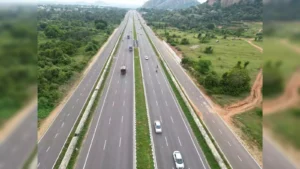
Why in news?
- Imagine a world in which potholes that ruin tires and jolt rides are nonexistent.
- Thanks to developments in self-healing roads systems, this futuristic image may not be as far off as you might imagine.
- The National Highways Authority of India (NHAI) is leading the way in investigating these cutting-edge approaches to build stronger, more reliable highways throughout the nation.
The Problem: Potholes and Perpetual Repairs
- India’s vast network of national highways plays a vital role in its economic development. However, these roads face constant wear and tear due to heavy traffic, extreme weather conditions, and fluctuations in temperature.
- This leads to a common enemy for drivers – potholes.
- These road defects not only cause inconvenience and damage vehicles but also pose safety hazards.
- Traditional road repairs are often disruptive, causing traffic congestion and delays.
The Solution: Self-Healing Roads Technologies
- Roads that can mend themselves are no longer the stuff of science fiction. Across the globe, researchers are coming up with clever ways to enable roadways to automatically fix small fractures and damage.
- Here’s a look at a few of the intriguing technologies being investigation:
- Microencapsulation: Imagine tiny capsules embedded within the asphalt. These capsules contain healing agents that get released upon the formation of cracks, sealing them and preventing further damage. This technology, pioneered by Delft University of Technology in the Netherlands, holds immense potential.
- Induction Heating: This method incorporates steel fibers into the asphalt mix. When cracks appear, an induction machine heats these fibers, causing the surrounding asphalt to melt and fill the gap. This approach is currently undergoing testing in countries like China and the Netherlands.
- Bacteria-Based Self-Healing: This innovative technique utilizes bacteria embedded in the concrete that produce calcium carbonate, a natural crack sealant. Researchers at Binghamton University in New York are actively exploring this bio-inspired solution.
- Rejuvenator Capsules: Similar to microencapsulation, this method uses capsules containing a rejuvenating agent. When released, this agent softens the surrounding asphalt, enabling it to flow and seal minor cracks. This technology is being tested on roads in Cambridgeshire, UK.
NHAI’s Approach: Infused Bitumen and Steel Fibers
- The NHAI is focusing on a self-healing method that combines infused bitumen (asphalt) and steel fibers within the asphalt mix.
- This approach leverages the properties of both materials – the bitumen’s ability to self-heal and the steel fibers’ capacity to bridge small cracks.
- This paves the way for a more sustainable and durable road infrastructure with minimal disruption caused by traditional repairs.
Implementation and the Road Ahead
- While these technologies are promising, large-scale implementation requires a thorough cost-benefit analysis. NHAI is taking the necessary steps to ensure the cost-effectiveness of self-healing roads before widespread adoption.
- Looking ahead, self-healing road technologies have the potential to revolutionize India’s transportation landscape. These innovative solutions offer numerous benefits:
- Reduced Maintenance Costs: Self-healing roads can significantly lower the long-term costs associated with frequent repairs and road closures.
- Improved Road Safety: By minimizing potholes and cracks, self-healing roads can enhance road safety for drivers and pedestrians.
- Enhanced Durability: These roads are expected to have a longer lifespan compared to conventional roads, reducing the need for frequent reconstruction.
- Sustainable Infrastructure: Self-healing roads promote a more sustainable approach to road construction by minimizing waste and resource consumption during repairs.
Conclusion: A Smoother Future for Indian Roads
- The exploration of self-healing road technologies by the NHAI signifies a commitment to building a more robust and sustainable road network for India.
- While challenges remain, researchers and road development authorities are optimistic about the future of these innovative solutions.
- As these technologies evolve and become more cost-effective, we can look forward to a future with fewer potholes and smoother journeys on Indian highways.
People also ask
Q1: What are self-healing roads?
Ans: Self-healing roads are a type of road technology that incorporates features allowing the road surface to repair minor cracks and damage automatically. This can be achieved through various methods, such as microcapsules containing healing agents, steel fibers that activate with heat, or even bacteria that produce a natural crack sealant.
Q2: Why is India exploring self-healing roads?
Ans: India’s vast national highway network suffers from frequent pothole formation due to heavy traffic, extreme weather, and temperature variations. Traditional repairs are disruptive and costly. Self-healing roads offer a potential solution for longer-lasting, more sustainable roads with minimal repair needs.
Q3: What approach is NHAI taking?
Ans: NHAI is focusing on a method that combines infused bitumen (asphalt) and steel fibers. The bitumen’s self-healing properties and the steel fibers’ ability to bridge small cracks offer a promising solution.
Q4: Is this technology in use yet?
Ans: No, large-scale implementation is on hold while NHAI conducts a cost-benefit analysis to ensure its economic feasibility.
Reading your article helped me a lot and I agree with you. But I still have some doubts, can you clarify for me? I’ll keep an eye out for your answers.
yes you can ask me through the comments i can clear your doubts.
Your point of view caught my eye and was very interesting. Thanks. I have a question for you.